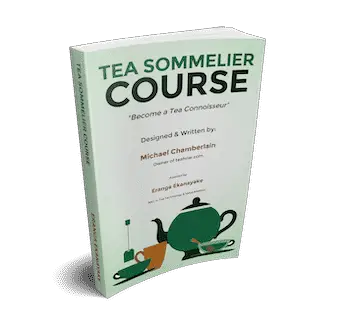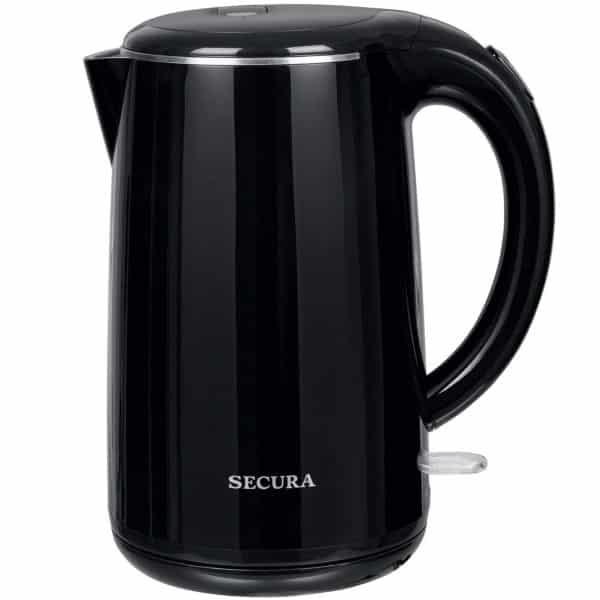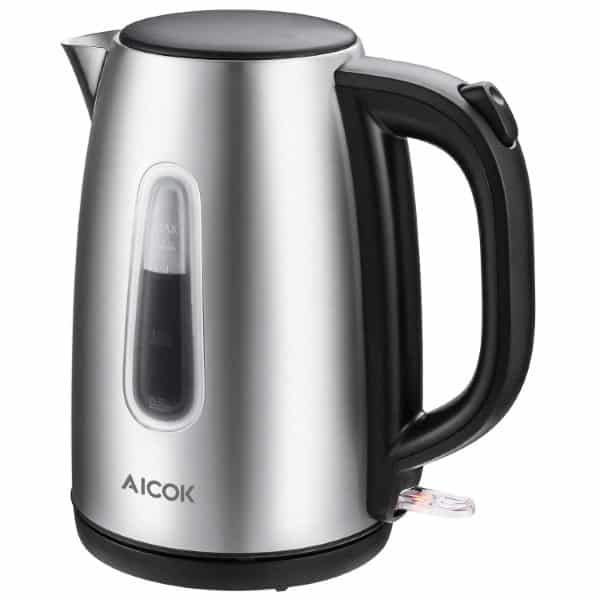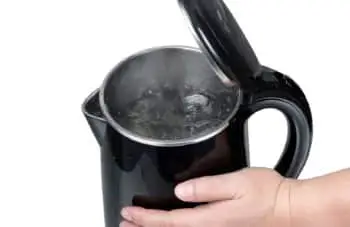Recently, I bought a new kettle.
I’ve rarely thought about what to do, I give it a quick rinse and off I go. In fact, I never really thought about what it was made of either and how that might
So, when you come to use your new kettle for the first time. There are a few general steps to follow to stop any bad odors or tastes!
Why Does My New Kettle Smell Bad? There are several reasons for the bad smell in new kettles. Water can smell bad due to manufacture chemicals coating the surface of the kettle reacting with the water. It could be BPA in the plastic which reacts with water. Or, if boiling hard water, minerals in the water can cause a bad smell.
If you usually just buy the best-looking kettle, and just wash it and start using it directly. Then you may want to think again.
To learn more about why your new kettle smells bad, keep reading on.
New Kettle Arrival
When new kettles are manufactured, the inner surface (and sometimes the outer surface) is coated with chemicals or lubricants by the manufacturer.
These chemicals are applied to the kettle during manufacture to protect it at certain parts of the production line, and to prevent it from rusting while it lies idle in warehouses and shops. Other than that, there should not be any visible chemicals in your kettle.
When you’ve received a kettle for the first time, it’s best to follow the instructions for setting up a new Kettle properly.
How To Prevent Bad Smell or Bad Taste From a New Kettle
Here are the basic instructions in brief as a quick takeaway for you.
- Step 1: Clean the kettle thoroughly.
- Step 2: Fill the kettle completely with water and boil.
- Step 3: Discard the water.
- Step 4: Repeat steps 2 and 3 for three or four times.
- Step 5: Start using the kettle.
It sounds easy. But it isn’t. Sometimes you cannot get rid of the foul smell and taste just by following these general instructions alone. Let’s look at each step carefully and come up with solutions for some common problems you might face during the process.
Why not check out 100 interesting facts About Tea
How to Clean New Kettles?
You probably noticed that your new kettle has stickers and tags on it. First, remove all the stickers and labels that are on the kettle.
After that, make sure that you wash it thoroughly with dishwashing soap or liquid. Be sure not to get water into any electrical parts of the unit.
Most kettles are coated with a chemical substance, this is mostly to prevent it from rusting when in storage. Also, when kettles are kept in shops or storage houses, they collect dust. To get rid of these chemicals and dust, clean the kettle thoroughly before anything else.
Did you know?
It can actually be bad to use boiled water to make tea
Instructions to Follow with Stovetop Kettles
Stovetop kettles are often made with materials like cast iron and copper. But most modern stovetop kettles are made of stainless steel. Whichever material your stovetop is made of, here are some steps in detail to follow to thoroughly clean and use them.
Step 1: Clean The Kettle
As I explained above, the first step that you should follow is to clean the kettle properly.
Step 2: Fill the Kettle Completely with Water and Boil
If you’re using a stovetop kettle, then be careful when following this step. Even though it says to fill the kettle completely, you should not fill it up to the brim!
If you do, water will spill out of the kettle’s spout while boiling. Instead, you should fill water up to the point where the spout starts from inside the kettle. This is true whenever you use the kettle.
Also, whilst using the kettle on the stove, be sure to keep the base of the kettle directly above the hot plate or burner if using gas. Don’t allow flames to come out from around the edges of the base of the kettle as it might melt the handle or even the spout, or for gas, it may
Stovetop kettles make a whistling sound once the water is boiled (actually they can get quite loud on some!). So as usual, turn off the stove when you hear the whistle as the water is now boiled.
Step 3: Discard the Water
The water is undrinkable after the first boil because the chemicals that were coating the inside of the kettle are now mixed into the water.
When you discard the boiled water after the first boil, you might notice changes in the color of the kettle base, especially so in copper kettles. Do not panic though. It’s just the chemical coming off the base. Just wipe the base inside with a fresh clean piece of cloth and then move on to step 4.
Step 4: Repeat for Step 2 and 3 for 3 or 4 Times
In some kettles, the bad taste and smell do not go after just boiling water once. In such cases, you will have to repeat the process of boiling water and discarding it several times until your kettle is fully cleaned and free of chemicals.
Step 5: Start Using the Kettle
You can now use the kettle to boil water from this point on. And use the boiled water to drink, or make a cup of tea.
Tip: If you are not satisfied with your current stovetop kettle, I recommend you check out brands like Willow & Everett, Cuisinart, and Bellemain. I’ve found them to be very good. They’re also the most popular and bestselling on Amazon.
Now your new kettle is ready to use, get better at making tea, and become the tea expert among your friends and family with my Tea Sommelier Course!

Take the fast track and become a tea connoisseur
Whether for enjoyment or considering a career as a tea sommelier. This course has everything you need to enhance your tea knowledge and tea-tasting skills.
This course keeps it simple with step-by-step tea tasting and easy reference guides
For pleasure, or as a precursor to a career in the tea industry. Find out what tea sommelier actually does, their career paths, and what they earn.

Find out more about the Teahow Tea Sommelier Course!
Instructions to Follow with Electric Kettles
When you are using an electric kettle for the first time, you can use the same steps which were explained under stovetop kettles. But there are a few important things that you should keep in mind.
● When you’re cleaning and washing the kettle, make sure that you DO NOT wash the power cable.
● Before you plug in the kettle, make sure that the base is dry. Also, check whether the plug is working and whether you have the correct pin hole connectivity to plug it in.
● When boiling water before you start using, fill the kettle up to the point which indicates the maximum water level. Do not fill above it.
● Your electric kettle would work only if you have correctly placed it on the power base and switched ON the power button. It will automatically switch off once the water is boiled.
Most people like electric kettles as they’re easier to use.
And you have a wide range of electric kettles to select from.
But not all electric kettles are the best quality or last long. So if you need a good electric kettle I recommend you check out brands like Breville, AmazonBasics, and Mueller – all available on Amazon. Or even if
What If the Water Still Tastes Bad?
If you followed the above steps and the water still tastes bad, there are few tricks that you can do.
Trick 1:
Add two tablespoons of bicarbonate into the kettle filled with water and boil. Then leave the kettle to cool overnight with the bicarbonate mixed water. Discard the water, wash the kettle and refill with water. Boil water and discard. Boil water and discard again to get rid of any remaining bicarbonate. Now your kettle should be free of any foul taste. Instead of bicarbonate, you could use lime as well.
Trick 2:
Fill half of the kettle with vinegar and the other half with water and boil. Leave it to cool overnight or at least for 2 hours. Then discard the solution and wash the kettle. Refill with water, boil and discard. Do it again. Then you can use your kettle in the normal way.
If none of the above works, the next best option that you have is to take the kettle back to the store and ask for a replacement or contact the manufacturer.
What Causes the Bad Smell or Bad Taste in a New Kettle?
If the water in your area is hard, it contains high amounts of magnesium and calcium. When these minerals react with the metal coating inside the kettle, water will taste bad. You can avoid this by boiling only filtered water in your kettle.
If the kettle is made out of plastic, the plastic starts melting when boiling water at very high temperatures. The kettle can start to smell bad due to melting plastic. This can be avoided though.
The reaction between plastic in the kettle and chlorine in the water. This reaction forms chlorophenol. This is what most of us call TCP or simply the plastic taste
To avoid this, you can use a BPA free kettle. This will list some kettles for you from Amazon. Or you can select one of my recommendations options below – depending on your preferred style, I’ve selected black, glass and stainless steel.

Stainless Steel Double Wall Electric Kettle 1.8 Quart
100% Stainless Steel Interior. Stainless Steel pot, Stainless Steel Lid, Stainless Steel Spout, Stainless Steel Rim. NO plastic in contact with hot water. Safe Healthy Drinking Water
BPA-Free Cool Touch Exterior, No Scalding Hazard. Saves Energy and Safe to Use.
1.7 Liter/ 1.8 Quart Capacity. Double-Wall Construction Boils Water Quicker and Keeps Warm Longer. Here’s the Link to Amazon
COSORI 1.7L Electric Kettle
- 100% BPA-Free plastic Made with the finest quality Borosilicate Glass which resists scratching and scuffing, no plastics touch the boiling water inside including the lid
- Safe Tech & Auto Shut Off
- Bue LED Indicator
- Quick Boil
- Wide Mouth & Easy to Clean
- Available here on Amazon


Stainless Steel Cordless Tea Kettle 1.7-L 1500W
- Fast boiling tea kettle
- Food grade stainless steel
- 1.7L large capacity
- Available Here on Amazon
Are the Taste and Smell Dangerous?
As you saw, your kettle can have different smells like plastic, chlorine, TCP, burning metal or simply a nasty smell. Most of these smells and odd tastes are not harmful except for one. That is the plastic smell.
The plastic smell in water is caused by BPA, which can cause many health problems. Some such health problems are cancer, infertility, heart disease, diabetes, asthma and deformations in unborn children. So, make sure that you do not drink water that smells and tastes like plastic.
Even though the other smells are not dangerous, I think that it is best not to drink that water either.
If You Feel Ill After Drinking Water from a New Kettle
I’m not a doctor, so if you feel ill after drinking smelly water from your new kettle, my advice for you is to seek medical advice from your doctor as soon as possible. You never know what is happening inside your body, so better get yourself checked.
Conclusion
So I learned how to start off with a new kettle the hard way. Because of that, I thought this was important enough to share my findings and hopefully help you to avoid such an unpleasant experience.
I hope this post was useful in finding out how to use your new kettle properly while getting rid of its bad taste and smell.
Don’t forget to check out my Tea Sommelier Course, and you might be interested in tea-ware as well. If so, check my curated and recommended tea-ware pages to learn more about products I’ve tried and tested.
Here’s Chef T’s version of how to clean your kettle…
Related Questions:
What is Better out of Electric Kettle and Stove Top Kettle? The most economical option is the electric kettle as it allows you to boil small amounts of water and even adjust the temperature according to your requirement. It’s also generally safer to use.
Can You Boil Milk in a Kettle? It is not advisable to boil milk in kettles as milk expands faster than water and does not evaporate like water. If you boil milk in a kettle, there is a high chance of milk overflowing, and getting burnt at the base or around the heating coil. This will disrupt the functioning of your kettle.

Glad I found this. We have had problems with plastic tasting water from plastic kettles for years and never found an answer to the problem. We now use an all metal one, a Breville, but it seems they have now discontinued it which is such a shame as its the only one that we have found that is all metal. it is not a jug type so not noisy.
Thanks for the great input Foster. Sounds like that might well be worth trying too.
I had a kettle from which the boiled water tasted bad. . I half filled it with warm water and added a desert spoon of ” Jif ” , an abrasive cleaner. Scrubbed around the inside surface with dish washing brush, including the lid.
Then warmed it a bit and discarded the contents. Refilled jug, several times and discarded contents . .
If water does not taste good enough, repeat the above.
There should be major improvement . . .